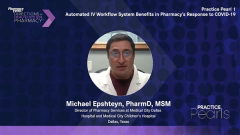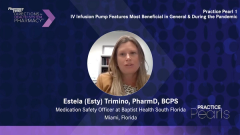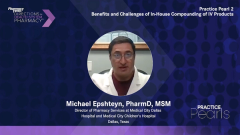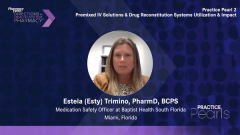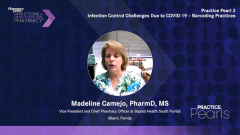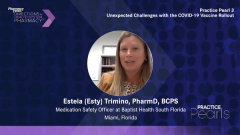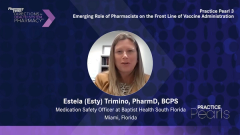
Practice Pearl 2: Premixed IV Solutions & Drug Reconstitution Systems Use & Impact
Estela Trimino, PharmD, BCPS, discusses the use and impact of premixed IV solutions and drug reconstitution systems compared to compounded IV products.
Episodes in this series

Madeline Camejo, PharmD, MS: Usually you are a pharmacy that does a lot of one thing; either you’re compounding a lot, or you do some premix, or try to throw everything at nursing while they’re trying to navigate with these patients. What have you seen in your organization, Esty? I’m talking about the utilization of premixed IV [intravenous] solutions, the drug reconstitution systems that Michael just discussed, and how does that compare to trying to compound the IV products in house? Can you discuss the impact on patient safety, from a safety officer perspective, and the impact on quality of each of the different IV products?
Estela (Esty) Trimino, PharmD, BCPS: Thank you. That was one of our hardest implementations; traditionally we had things…either premixed or made by pharmacy. It’s a balance. When you’re looking at what you’re going to put on the floor versus what you have in the pharmacy, you have to take an assessment and say, from a safety perspective, “Can I put this medication on the floor safely, and a nurse can attach it,” and you have the drug readily available. The way we worked with nursing is, pharmacy is working very diligently to get these medications to you. And again, staffing was a challenge with COVID-19, not only in our hospital, we saw it in our pharmacies. We had decreases in production, per se, in the pharmacy team. Having those products with connectors available for nursing is good for pharmacy as well as for nursing because it puts those medications up there. You’re not waiting for it to be delivered by pharmacy. We evaluated which products were going to be used with the connectors andcould be used with the connectors. Now, there were challenges with the connectors during COVID-19 because some of these products were not available, so you might have had multiple types of adapters. From pharmacy, we get them and we have them there. But from a nursing point of view, the challenge would be education of, can we roll these out in enough time that all our nursing staff, which is more than pharmacy, would know how to do these and have them available?
In the beginning it was “Why nursing? We have so much going on, we have so many patients we’re taking care of. We can’t do an extra step,” versus once we have the product and the connectors. What we did in our system is we implemented pieces of it. We would go to 1 drug in the ICU, [intensive care unit], then we would go in house. Our strategy was it was easier in ICU, since our numbers were low on the medical-surgical floors, and the education was more isolated in those areas. Again, we went through premixes if they were available, in as many instances as we could. Now that some of our [COVID-19 case] numbers, at least at [Baptist Health] South Florida, have gone down we’re going to think about we optimize what we have in our machines because we don’t want to continue. You must balance the cost versus production and the safety as well.
Analyzing what products you’re doing the connectors with is going to be valuable. Definitely it’s time-saving for nursing as far as waiting for patients, having their medications available on the floor, after pharmacy verification, obviously. Then from the pharmacy workflow, it also frees up more IV items that need to be prepared with some of these COVID-19 newer therapies that are coming out that need to be mixed in pharmacy,
I know you asked a little about the quality of the IV products, so once they are there, we’re not attaching anything to these products, so these connectors are allowing the drug to sit there as part of inventory. Only when activated will that beyond-use dating start, and if expired, it has to go. This helped us a lot, Madeline, in our system because of the way when we started, a lesson learned from New York, the epicenter, was the quarantine of medication. The more things we mixed that would come down to pharmacy, we had to quarantine some of these medications for a couple of days. Then we eventually got more creative with the swabbing and cleaning of these products, and then just waiting minimal days for them to get back in stock. But imagine in the time where you have shortages and you’re trying to get these products back up, it freed some of those products to be available and decreased the quarantine time for those products in pharmacy.
Transcript edited for clarity.
Newsletter
Stay informed on drug updates, treatment guidelines, and pharmacy practice trends—subscribe to Pharmacy Times for weekly clinical insights.

